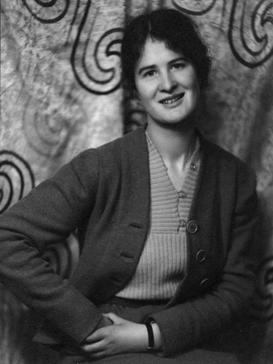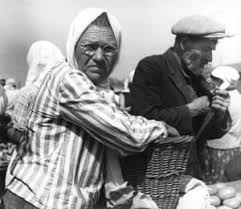In early October 2020, the Bodleian Libraries launched an exhibition of the works of pioneering portrait photographer Helen Muspratt (1907-2001).
The retrospective marks the recent gift of her photographic archive to the Bodleian, including over 2000 original prints, and forms part of the Photo Oxford Festival 2020, which takes Women and Photography as its theme.
For over thirty years, this widely-acclaimed photographer had a studio at 23 Cornmarket Street, in the building where WHSmith is now located, and which Jesus College owns. If you look up above the shop front you’ll see the beautiful bay window which lit the main work room, and on the floor above she lived with her husband and three children. Helen, and her business partner Lettice Ramsey, first leased the property from the College in the mid-1930s, but her career as an innovative and experimental photographer began ten years before.
Helen Muspratt (above) was inspired to take up photography after being photographed herself by the studio portraitist Constance Ellis. In 1926 she enrolled on a photography course at the renowned Regent’s Street Polytechnic, and set up her first studio in the Muspratt family’s home town of Swanage three years later, specialising in portraiture. She was hugely influenced by the work of Man Ray – especially his experimentation with solarisation – and began to explore similar techniques in her own work. It wasn’t long before her talent for portraiture was spotted and admired, with the magazine British Photography describing her studio as one where ‘every aspect reflects the personality of an individual photographer’.
Helen explored many different styles and genres, but critical to all her work was a preoccupation with the face – its ‘shape and angle’ – and she soon became an eminent portrait photographer who was able to record some of the leading figures of the twentieth century. She became friends with members of the avant-garde Corfe Castle arts group and photographed them many times. Dancers Hilda and Mary Spencer Watson, the artists Eileen Agar and Paul Nash, and the singer David Brynley all became the subjects of some of her most captivating modernistic portraits.
In 1932, Helen met a kindred spirit in the form of fellow photographer Lettice Ramsey, and together they established the studio of Ramsey & Muspratt in Cambridge. It was a hugely creative time in her career – the studio became a fashionable venue for young Cambridge intellectuals – and her most well-known work comes from this period; John Cornfield, about to set off for death in the Spanish Civil War, and her portraits of future secret agents Burgess and McLean.
Her experiences in Cambridge gave Helen a keen interest in politics and, in 1936, she set off to the Soviet Union to document ‘a revolutionary society’. She succeeded in capturing the essence of the ‘struggle’ of the peasants and farmers, and extended this social documentary work in a series of portraits she took the following year on a visit to South Wales, where she photographed Rhondda miners and their families.
In the late thirties, Helen’s life shifted towards marriage and family. She married the labour activist Jack Dunman in 1937 and became the major income earner, so he could focus on his political work. The pressure of being a main breadwinner, plus parent to three young children, meant she had to set aside her experimental portraiture for more commercial commissions. It was in this year that Helen moved to Oxford and opened the second Ramsey & Muspratt at 23 Cornmarket Street.
She would lease the property from Jesus College for the next thirty years, and who knows how many visitors sat for portraits over that time. Our archives show that, in October 1969, the lease was renewed to Mrs H. M. Dunman (Ramsey & Muspratt) for the second and third floors of 23 Cornmarket Street, with the right to exhibit photographs in showcases in the passage and on the stairs. The archives also show that in August 1977, Helen – now a widow – surrendered her lease to the College.
She retired to Brighton, where she continued to be politically active for many years, and died at the age of ninety-four. Wider recognition of Helen’s work came with the 1986-87 touring exhibition ‘Women’s Photography in Britain’ and she was featured in many documentaries about women pioneers, such as the BBC’s Women of Our Century (1990). The National Portrait Gallery now holds fifteen of her portrait photographs, and her archive has been donated to the Bodleian Libraries, to be enjoyed by generations to come.
Find out more about the Bodleian Libraries’ exhibition of Helen Muspratt’s work here.


